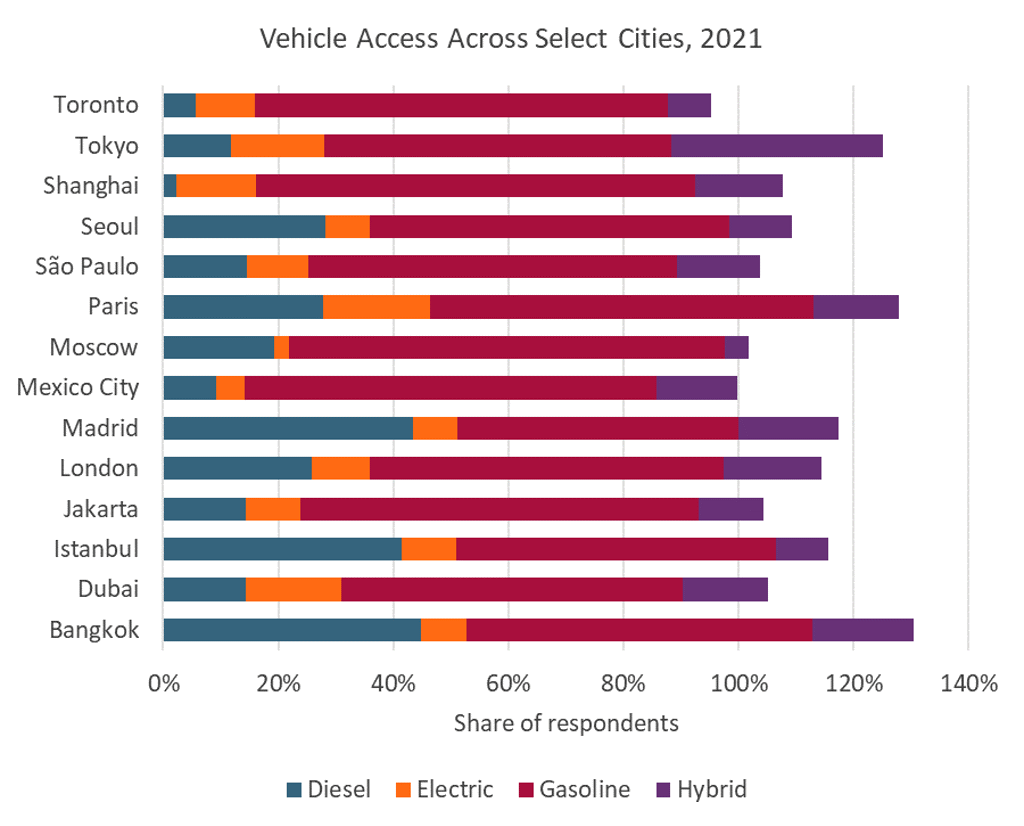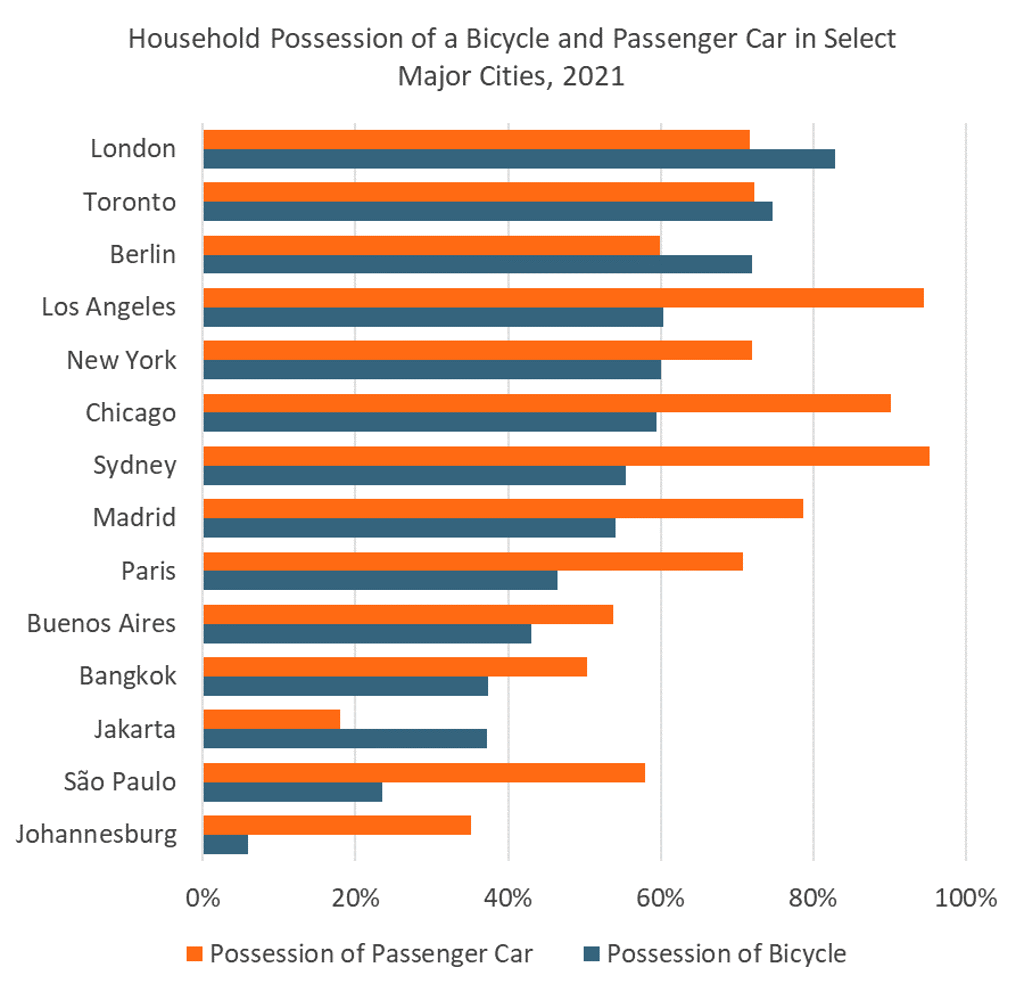Sustainable mobility is a rising agenda for governments and urban planners as the world grapples with the threat of climate change. Municipal governments are taking a stricter stance on internal combustion engine vehicles, while simultaneously promoting alternative mobility solutions such as cycling, walking and shared mobility. Global policies on climate change action such as the Paris Agreement and the United Nations 2030 Agenda for Sustainable Development, form a central role in the pursuit of sustainable mobility.
Low emission vehicles
Cities need to set and implement clear goals in promoting low emission vehicles. The mission for cities is to develop an urban framework that places greater value on health and liveability, especially at a time when global urbanisation rates are surging. By 2040, 64% of the world’s population is predicted to live in urban areas. The rising demand for mobility in cities will warrant an eco-friendlier approach to how people move around. This will, in turn, help improve air quality levels and reduce the transport sector’s impact on fossil fuel emissions; in 2020, 24% of all direct carbon dioxide emissions were generated from the burning of fossil fuels in the transport sector.
Electric vehicles are seen as one solution to achieving lower emissions. Across 46 major countries, the number of new electric vehicles registered (battery, plug-in electric and hybrid electric vehicles) recorded a 25% CAGR over 2015-2020. By 2040, 84% of new vehicle registrations will be electric. Several cities are seeking to advance the adoption of low emission vehicles through stricter regulations on fossil fuel powered cars. Paris announced a ban on diesel and petrol cars from its roads by 2030; Athens has set a ban on diesel vehicles from 2025, and other cities such as Madrid, Rome and Stockholm are following with similar initiatives by implementing stricter controls on high emission vehicles.
Nonetheless, as cities shift to low emission mobility, municipal governments must provide the necessary environment for consumers and businesses to make the clean mobility switch. This involves providing scrappage schemes whereby small businesses can trade high-emission vehicles in exchange for a monetary value, the provision of subsidies towards the purchase of low emission vehicles, and investment in electric charging infrastructure. It is fair to say that the transition to low emission vehicles is easiest for high-income earners but poses a much greater challenge for the less affluent.

Note: Cities included with a sample size of 50 or more
Q: How many of the following types of automobiles does your household own?
A: At least one
Source: Euromonitor International Mobility Survey 2021
Mobility-as-a-Service
Mobility-as-a-Service (MaaS) is the future of urban transport. It integrates public transport, shared mobility, and other available transport modes into one through a subscription or pay-as-you-use pricing model. It seeks to make personal cars obsolete, by offering a holistic transport network that solves first and last mile challenges and delivers efficiency gains through real-time data applications.
The rising uptake of smartphones and wireless internet is one of the main enablers of MaaS. In 2013, just 30.8% of the total global population used a mobile phone to access the internet – by 2020 this had risen to 51%. In developed cities such as New York, London, Paris, and Tokyo, over 87% of households had access to broadband internet. Meanwhile, internet access rates are rapidly improving in emerging and developing cities.
While the idea is still nascent, some cities such as Helsinki, Antwerp and Berlin have experimented and introduced MaaS as a mobility solution. In Berlin, BVG Jelbi is the only app available in the city that integrates all public transport and shared mobility options in one place. Whim, one of the pioneers of MaaS after introducing its service in Helsinki in 2017, has expanded its services to cover several cities including Antwerp, Vienna, Turku and Birmingham.
However, the rollout of MaaS will pose challenges including the need for sophisticated payment integration systems, viable pricing models catering to all income groups, data sharing protocols that do not breach data protection laws, and the deployment of ticket validation systems. Furthermore, it will require robust cooperation between public and private bodies to deliver an efficient transport system. Private firms will need to weigh up the costs and benefits of partnering with other private mobility providers and municipal governments.
Micromobility
Micromobility, the use of lightweight vehicles, typically with speeds up to 25 km/h such as bicycles and scooters, is being championed across cities as a tool for sustainable mobility. Cities are leveraging micromobility to reduce the number of vehicles on roads, promote healthier lifestyles, reduce noise pollution, and curtail carbon emissions. During the COVID-19 pandemic, in light of social distancing measures, cities including Bogota, Paris and Berlin actively encouraged cycling by introducing pop-up bicycle lanes.
Micromobility forms a relatively small proportion of all commuting in comparison to passenger car use or public transport. In Euromonitor International’s Voice of the Consumer: Mobility Survey 2021, only 9.8% of global respondents typically commuted by bicycle – much lower when compared to using passenger cars (48.9%) and public transport (37.7%). However, some cities such as Bogota and Amsterdam have managed to buck the trend and develop an environment conducive to cycling and other micromobility use – the 2021 Mobility Survey also found that 27% and 18% of respondents typically commuted by bicycle in the two cities, respectively. Furthermore, Bogota and Amsterdam were ranked among the 20 best cities for cycling friendliness in the 2019 version of the Copenhagenize Index. Their success is owed to active investment in dedicated cycle lanes and events promoting cycling and car-free days.
The challenge to expanding micromobility is delivering enough infrastructure investment into dedicated bicycles lanes, bicycles locks and storage places. Secondly, regulatory bottlenecks and grey areas, especially with newer modes of micromobility such as electric bicycles and scooters, can leave people unsure of the legal implications of their use in cities. Finally, climatic challenges with harsh winters, as is typical in Northern climates, can make micromobility a seasonal showing.

Note: data for 2021 is forecast
Climate and sustainability pressures are forcing cities to rethink urban mobility habits. Low emission vehicles, mobility as a service and micromobility are some of the key solutions which can alleviate challenges and help navigate the future of mobility. Yet, this does not conceal the hurdles which are expected to emerge as cities transition away from personal cars. It will require time and effort to implement infrastructure, ensure inclusive mobility, and ensure that municipal governments offer the necessary support to lower-income households. What is also vital to understand is that changes in urban mobility will usher an indirect transformation of the built environment in cities. It will stem from the changing relationships people will have with their neighbourhoods as commuting patterns shift, impacting the spatial distribution of retailers, local service providers and the development of commercial, retail, and residential real estate.
